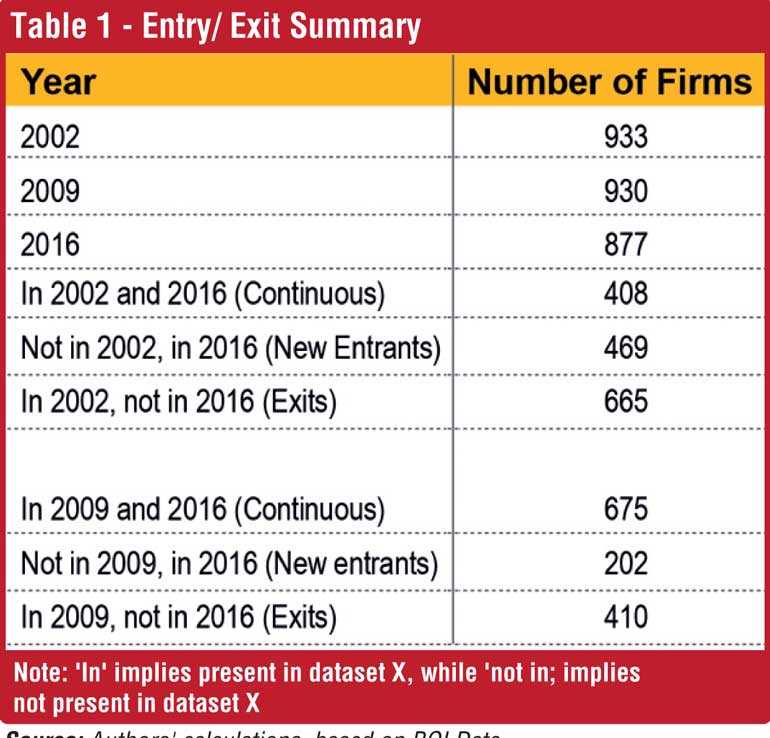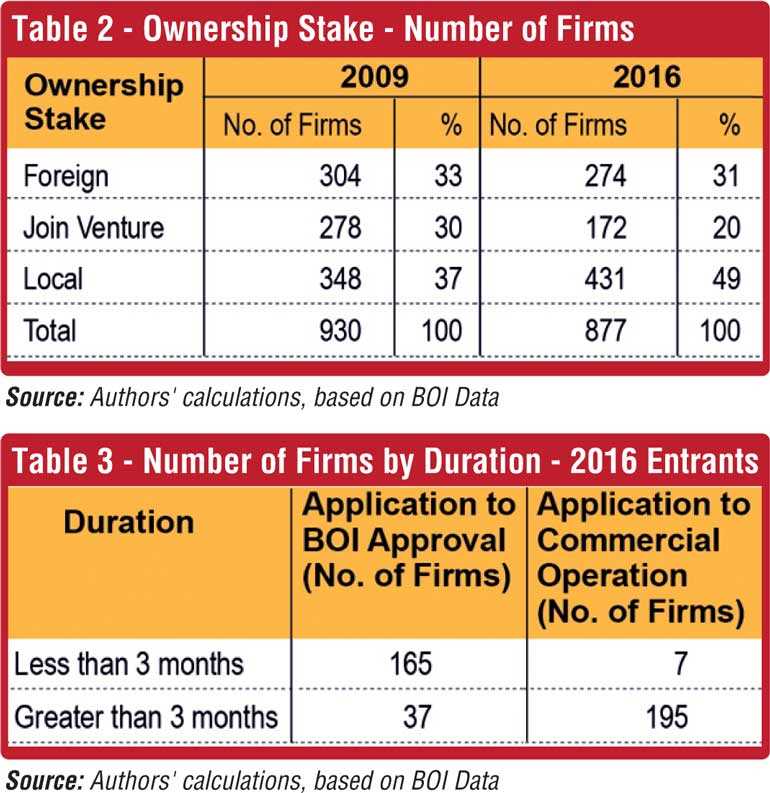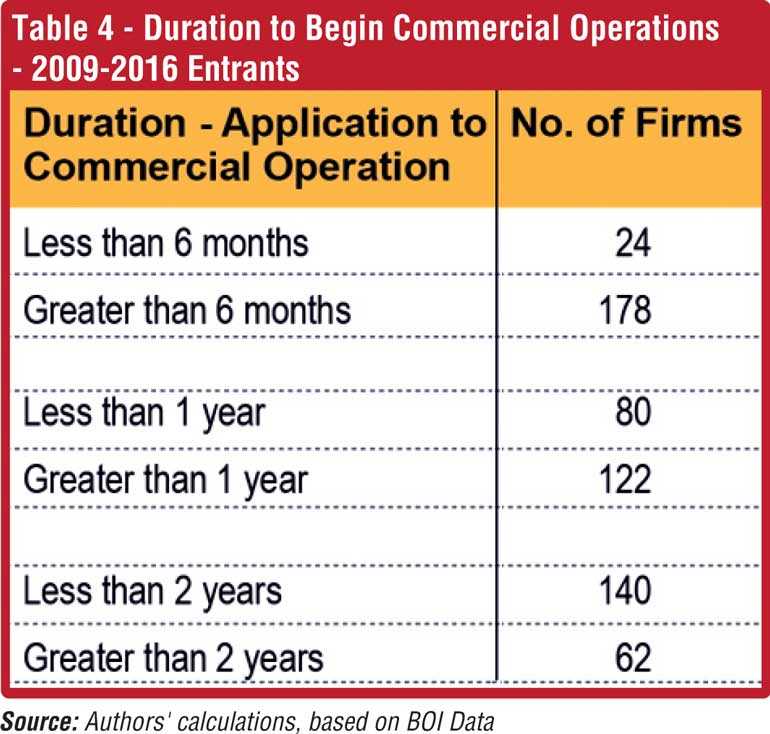Tuesday Mar 18, 2025
Tuesday Mar 18, 2025
Friday, 28 September 2018 00:00 - - {{hitsCtrl.values.hits}}


 By Institute of Policy Studies
By Institute of Policy Studies
Although Foreign Direct Investment (FDI) inflows to Sri Lanka have ‘recovered’ in 2017, hitting the much-touted $ 1 billion landmark, the underlying bottlenecks of poor ease of doing business, attracting the wrong ‘types’ of investments, and policy uncertainty have prevented Sri Lanka from ushering in optimal FDI gains throughout the post-war period.
This study delves into firm-level investments in Sri Lanka’s manufacturing sector to further explore these bottlenecks. Three firm-level datasets of Board of Investments (BOI) enterprises for the years 2002, 2009, and 2016 were used for this purpose, and a comparative analysis between datasets was conducted. Three key takeaways from the analysis are discussed below.
High firm turnover
Firm turnover is high, in both the short and the long term (Table 1). An entry/exit analysis found that, compared to the number of entrants (202), twice as many firms have exited (410) in the post-conflict period from 2009 to 2016, while exits are relatively higher than entrants (665 vs 469) even in the long term.
However, it should be noted that the authors’ definition for ‘exits’ is firms that are absent in a later dataset but present in a previous dataset, and vice versa for entrant firms; this implies that Table 1 displays not the total number of entrants and exits within a period, but rather the comparative difference between the two time periods.
Furthermore, of the 933 firms that were in operation in 2002, only 408 have continued operations till 2016. In the post conflict period, of the 930 firms that were in operation in 2009, only 675 firms have continued operations till 2016.
The turnover in the textiles and garments (T&G) sector is particularly high relative to other manufacturing sub-sectors in both periods under analysis; almost double the number of entrant firms have exited in the 2002-2016 period (150 vs. 255), while over double the number of firms exited within the 2009-2016 period (59 vs. 146). This is potentially a reflection of the footloose nature of T&G, where firms are highly mobile, and are constantly on the lookout for low cost locations for production.
While labour intensive components of production have been shifted to low wage countries like Sri Lanka, Bangladesh, Philippines, Thailand, etc., production is now shifting to bases with even lower costs, such as Vietnam, Cambodia, and Laos. The relatively high exits in the T&G sector could be a reflection of this shift, given that Sri Lanka’s labour costs have steadily increased.
In addition, firms in this sector generally seek preferential access to markets in developing economies through schemes such as the GSP Plus programme.
Therefore, while it is difficult to solely attribute the exit of firms in the T&G sector to Sri Lanka’s loss of GSP Plus concessions in 2010, it may have been a factor.
This aside, the high turnover of firms which characterises almost all sub-sectors of Sri Lanka’s manufacturing sector, is a cause for concern. This phenomenon appears to be linked with the type of investments that are predominantly coming into Sri Lanka: incentive-seeking rather than efficiency seeking investments.
Incentive seeking investments are more ‘footloose’ and tend to move between locations and engage in ‘incentive shopping’. Attracting more efficiency-seeking FDI that are ‘here to stay’ relies on strengthening the trade-investment nexus via Free Trade Agreements (FTAs), along with institutional/regulatory steps that encourage efficiency gains rather than incentive shopping.
(This Policy Insight is based on findings from a study on ‘Firm-Level Analysis of Manufacturing Sector Investment in Sri Lanka’ by Kithmina Hewage and Harini Weerasekera. email [email protected].)
Contd.on Page 25
Firm composition shifting away from Joint Ventures
The datasets analysed comprised of manufacturing firms that are locally owned, foreign owned, as well as joint ventures. Ideally, Sri Lanka’s share of joint ventures should be increasing, in the interest of reaping the benefits of joint venture investments for a developing country like Sri Lanka, such as technology upgrading/transfers and providing links to global value chains. However, the share of joint ventures has declined from 30 to 20%, while the share of locally owned firms has increased from 37 to 49% between 2009 and 2016.
Whilst some of the changes could be attributed to an increase in the number of domestic investors, the number of reductions in foreign and joint ventures are considerably higher. This trend is likely due to protectionist trade and investment policies restricting the investment space. For instance, policies such as the Land (Restrictions on Alienation) Act in 2014, which restricted foreigners from buying land in Sri Lanka, reduced the security of foreign investment and made the country a less desirable location for FDI.
Beginning commercial operations is time consuming
A duration analysis of the time taken to set up business in Sri Lanka was conducted, using the sample of 202 entrant firms in the 2009-2016 period. Two stages of the business start-up process were considered: (1) application to BOI approval (2) application to the beginning of commercial operations.
It takes less than three months for a majority of firms (165 of 202) to obtain BOI approval, from the point of submitting an application to the BOI. This is in line with the World Bank’s ‘Investing Across Borders’ database, which finds that it takes six procedures and 65 days to establish a foreign-owned Limited Liability Company (LLC) in Sri Lanka. However, the time taken for most firms to begin commercial operations, in the period after gaining BOI approval, is far longer.
Only seven out of 202 firms began commercial operations in a period of less than three months. Only 24 firms were able to begin commercial operations in less than six months and only 80 firms were able to do so in less than one year. The majority (over 50%) of firms took over a year to begin operations and 62 firms (30%) took over two years to begin operations, from the time of submitting an application to the BOI. This is because investors are referred to different ministries/agencies to obtain other required approvals (VAT registration from Inland Revenue, import export registration from Sri Lanka Customs, registration with utilities authorities).
As per the National Budget proposals for 2018, the government proposes to establish a ‘National Single Window’ to overcome these failings. This will enable foreign investors to apply on an online registration platform, and undergo a fast-track approval process that doesn’t require approvals from different line agencies, as per the current procedure in place.
To this end, the BOI has established a Single Window Investment Facilitation Taskforce (SWIFT) with the Inland Revenue Department, Registrar of Companies, Sri Lanka Customs, Urban Development Authority, Colombo Municipal Council and Central Environment Authority, at the time of writing. By the end of 2018, the BOI plans to extend this to 18 more line agencies to collectively incorporate a total of 24 agencies, which will cover the majority of approvals necessary for foreign companies that are planning to establish themselves in Sri Lanka.
Way forward
While the broader requirement of ‘policy consistency’ is challenging to achieve, quick-wins such as speeding up the approval process for investors and re-orientation towards attracting more efficiency seeking FDI into the country, should be prioritised in the short-term. The current policy environment, where the government is aiming to liberalise existing restrictions on foreign entry on certain sectors and make land ownership laws less restrictive for foreigners, along with the BOIs recently implemented SWIFT facility, are all positive steps in this direction.
Whether these efforts come to fruition and for how long a supportive policy environment is sustained, will undoubtedly affect whether Sri Lanka witnesses an improvement in firm-level outcomes for manufacturing sector investments in the country.
Discover Kapruka, the leading online shopping platform in Sri Lanka, where you can conveniently send Gifts and Flowers to your loved ones for any event including Valentine ’s Day. Explore a wide range of popular Shopping Categories on Kapruka, including Toys, Groceries, Electronics, Birthday Cakes, Fruits, Chocolates, Flower Bouquets, Clothing, Watches, Lingerie, Gift Sets and Jewellery. Also if you’re interested in selling with Kapruka, Partner Central by Kapruka is the best solution to start with. Moreover, through Kapruka Global Shop, you can also enjoy the convenience of purchasing products from renowned platforms like Amazon and eBay and have them delivered to Sri Lanka.
Discover Kapruka, the leading online shopping platform in Sri Lanka, where you can conveniently send Gifts and Flowers to your loved ones for any event including Valentine ’s Day. Explore a wide range of popular Shopping Categories on Kapruka, including Toys, Groceries, Electronics, Birthday Cakes, Fruits, Chocolates, Flower Bouquets, Clothing, Watches, Lingerie, Gift Sets and Jewellery. Also if you’re interested in selling with Kapruka, Partner Central by Kapruka is the best solution to start with. Moreover, through Kapruka Global Shop, you can also enjoy the convenience of purchasing products from renowned platforms like Amazon and eBay and have them delivered to Sri Lanka.